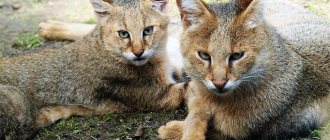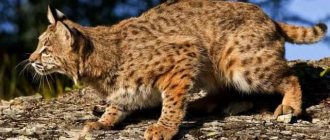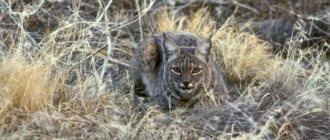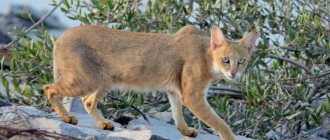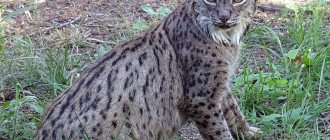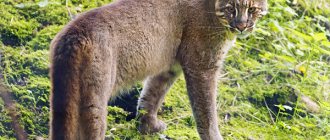What will you learn from the article?
- Origin story
- Appearance of a jungle cat
- Character
- Is it possible to keep a jungle cat at home?
- Health
- Caring for a jungle cat
- Feeding
- Where to buy a reed kitten?
Some become fans of the TV series House, while others enjoy the charm of the jungle cat, which is also called... yes, that's right - house. So, meet the jungle cat, aka house, aka swamp lynx or, scientifically, Felis chaus!
The jungle cat is a true predator that once lived in 25 countries. Nowadays, he lives only in zoos or in the apartments of his fans.
Origin of the swamp cat and domestication
This feline species was first described in scientific literature in the mid-18th century. The first cases of domestication of the jungle cat date back to Ancient Egypt. This animal reacted quite calmly to living next to a person. The images found suggest that the ancient race often used the Hausa to hunt hares.
In its natural habitats, this predator is very careful and silent, trying not to contact people for whom it does not pose a danger. But during rutting periods it is better not to meet with him. At this time the animal is quite aggressive.
This is a nocturnal animal that loves to hunt small rodents and birds, preferring especially overgrown areas for this. When living in an apartment or house, they retain their habits - they prefer to sleep during the day and show signs of activity at night.
Photo gallery of the jungle cat:
History of the species
The history of jungle cats begins when the ancient Egyptians domesticated a subspecies of the cat called Felis chaus. This is a type of African cat, the image of which is preserved on many famous figurines from the times of Ancient Egypt.
The ancient Egyptians domesticated African cats from nearby territories.
These were excellent hunters who brought prey to their masters and replaced dogs as guards. Beginning in the 18th century, attempts began to crossbreed the jungle cat with other representatives of cat breeds in order to breed a pet that could retain a developed hunting instinct combined with an amiable character.
IMPORTANT: Wikipedia indicates that the “reed cat” species was first described by the imperial naturalist Johann Anton Güldenstedt in 1776.
Currently, the wild reed cat lives in more than 20 countries around the world, and the largest representatives of the subspecies have settled in the Caucasus. Reed cats or “swamp lynxes” prefer to live next to people, which often causes discontent among the latter: the wild habits of these animals can deprive the farm of a significant number of small livestock.
The jungle cat, although not ferocious, is still a wild and unpredictable beast
IMPORTANT: the jungle cat is listed in the Red Book of Russia and is protected by law.
The jungle cat is used in breeding, bringing into the world exotic offspring. One of these original breeds is the Chausie - a mixture of the jungle and Abyssinian cat, which was bred and officially registered in 1995.
The photo shows a representative of the Chausie breed
In its pure form, the total number of representatives of the subspecies falls annually, which is associated with continuous deforestation and the death of animals in forest fires, which often burn in the steppe regions of their habitat.
Subspecies of the jungle cat
The jungle cat has ten subspecies living in the wild in Asia, China, Indochina and Indonesia, Transcaucasia, Dagestan, Stavropol and North Ossetia.
Caucasian jungle cat (Felis chaus chaus)
Described by Schreber in 1777, this main subspecies is found in Russia (in the northwest of the Caspian Sea within the Astrakhan region, Kalmykia of Dagestan, Chechnya, Ingushetia and North Ossetia), Azerbaijan, Armenia, Georgia, Turkmenistan, Iran, Iraq, Syria, some parts of Turkey.
Turkestan jungle cat (Felis chaus oxiana)
You can meet the cat in Central Asia, apparently in northern Afghanistan. The coloring of the subspecies is lighter than that of the previous Caucasian one.
Felis chaus affinis
Gray described cats in 1830. This subspecies lives in the Himalayas (from Kashmir and Nepal to Sikkim and Yunnan). It differs from the well-known typical Caucasian reed cat in that its fur is not so long and rich, and its skull and teeth are smaller.
Felis chaus fulvidina
The subspecies was characterized by the scientist Thomas in 1929. It lives in southeast Asia, its exact distribution is unknown.
Felis chaus furax
This predator can be found in Palestine, Israel, Jordan, and Lebanon. Also in Turkey and southwest Syria. This cat has larger teeth than our Caucasian jungle cat.
Felis chaus kelaarti
Distributed throughout Sri Lanka and southern India.
Felis chaus kutas
It lives in the north and center of India, as well as in northern Pakistan.
Felis chaus maimanah
Distributed in northwestern Afghanistan.
Felis chaus nilotica
It lives in Egypt, mainly along the Nile. It is distinguished by a generally darker color than, for example, the furax subspecies.
Felis chaus prateri
Lives in Pakistan and a small part of western India.
Description of the animal
House is a medium-sized cat, but much larger than any domestic cat. Its distinctive features include:
- Slender and muscular, not too long, the body of an athlete, reaching one meter together with the tail in especially large specimens.
- The tail is significantly shorter than that of most cat species (up to 30 cm).
- The paws are long, slender and muscular, ending in large pads with powerful claws.
- High-set, medium-sized ears may have small tufts.
- Like all wild cat species, the Hausa has light spots on the back surfaces of its ears - false “eyes”. It is along them that the brood, following its mother at dusk, orients itself.
- The color of the short, dense coat is ticked - from yellowish-gray to brick-brown with noticeable gray hair.
- The muzzle is large, heavy, slightly elongated, with an elongated nose ending in a convex brick-colored lobe.
- The eyes can be topaz or emerald shades, depending on the shade of the coat.
- Large individuals weigh a little more than twenty kilograms. Domesticated ones are usually smaller than their wild relatives.
- In captivity they can live more than fifteen years, wild individuals live a little less.
This strong, large and heavy animal for a domestic cat is very graceful and agile.
Behavior
These cats are usually active during the day; activity tends to decrease during hot hours. They rest in burrows, grass thickets and bushes. On winter days, marsh lynxes often like to sunbathe in the sun. At night, they are capable of walking 3-6 kilometers, although this is likely dependent on prey availability. The behavior of jungle cats has not been widely studied. Solitary by nature, they do not interact with each other, with the exception of the mating season and raising offspring.
Home range
Hausa have home ranges of 45 to 180 km², the boundaries of which are probably marked by indirect means such as olfactory markings.
Mr. Cat recommends: features
In nature, the house lives in thickets of bushes and reeds growing along the banks of water bodies; it is an excellent swimmer and fisherman. These are due to his love for water and at home.
In addition, water procedures allow them to keep their thick fur in order; House does not emit a specific cat smell, unlike other representatives of domestic cat breeds. Therefore, it is worth taking care of organizing a place for the animal to bathe.
This is a very devoted and faithful creature, but he will not sit on his lap if he does not want to. It is worth considering the peculiarity of this type of cat and not keeping it in families with small children. They will unnecessarily irritate the pet with their increased attention, and he, in turn, can cause injury to them (do not forget about his size and wild past).
At the same time, the animal feels absolutely comfortable in the vicinity of dogs, provided that they also do not show particular persistence in communicating with him. If the family has birds or rodents, you should take care of their safety, as the house will hunt them.
Thanks to their fairly high intelligence and memory, these large cats easily open doors and remember where the things that interest them are. Due to their flexibility and developed muscles, they often use furniture as sports equipment, while climbing to the very top. So it is useless to hide objects from them on cabinets and shelves - they will climb into them with ease and even pleasure.
This is a very kind and obedient animal, requiring, like other representatives of cats, care, attention, affection and care.
Where does it live?
Swamp lynx, house, jungle or Nile cat - all these are names for one representative of the cat family that lives in tugai forests and dense reeds. Representatives of the breed lead a solitary lifestyle, do not like open areas, but sometimes make forays and come to desert places with lumpy sands. However, the animal does not go far from its habitat. In winter and spring, the predator enters settlements to hunt poultry. In mountainous areas, the house does not rise above 100 m, since heat-loving cats do not like frost and snow.
Houses are attracted to the banks of ponds with lush vegetation, where they can hunt ducks and other animals. Cats make shelters in thickets of reeds or intertwined bushes. At the same time, the animal does not make holes, preferring to occupy ready-made abandoned dwellings of foxes or badgers. Marsh lynxes do not stay in one place for a long time, periodically changing shelters. Cats often approach the coastal strip, leaving tracks on muddy areas and shallows.
Cats swim well, dive for fish, and dive into water to eliminate their own smell. The latter distinguishes the jungle cat from the domestic breed, which tends to leave odorous traces everywhere (this is how the animal marks its territory). Wild cats live in the territory:
- Kazakhstan;
- low-lying banks of the Nile and Volga;
- Indochina;
- Iran;
- Dagestan;
- Eastern Turkey;
- India;
- Palestine;
- Caucasian forests;
- river openings of Central Asia.
Personality of the pet
Natural species of Hausa have a reserved and cautious character. These nocturnal hunters are extremely silent, changing their habits only during the mating period, which occurs at the end of winter and beginning of spring. The domesticated jungle cat, while maintaining the inherent caution of the species, is able to show curiosity and sociability, and be a playful and active pet. More often than not, House chooses one owner for himself, and his devotion is truly dog-like. But he also treats other household members with patience and kindness.
Currently, a mixture of the swamp lynx with the Abyssinian cat breed is very popular. Such animals are called Chausie. They look exactly like their wild relatives, but differ from them in their kind and affectionate character.
Chausie cat
It is worth consulting with your veterinarian about the possibility of spaying or neutering. If there are no plans to breed this type of cat, it is better to carry out such an operation, this will not only increase the life expectancy of the pet, but will also get rid of territory marks around the apartment, which will protect against unpleasant odors.
It is imperative to purchase a scratching post and a large litter tray for the animal; a regular cat litter box will not work. Also give them a bath periodically, as they love to bathe.
What and how to feed in captivity
The jungle cat eats once a day, and the diet consists of 200 grams of lean meat (mainly beef), 1 live rat or 2 mice). Live food can be day-old chicks or quails. You can give your cat fresh fish once a week. An important detail of the diet is fasting days, during which the predator fasts for the whole day. Your pet should be unloaded no more than once a week. Such strict measures are needed to save the animal from excess weight. To maintain your pet's health, follow these rules:
- Feed kittens up to a year 2 times a day, after a year - 1 time;
- be sure to supplement the animal’s menu with vitamins, mineral mixtures, and fresh herbs;
- do not refuse to feed plant foods or live food;
- Give your cat a fasting day once every 7-10 days.
Health
Such a cat has excellent health and immunity, since its genes were selected by nature itself. They are completely free of any hereditary diseases that are typical for artificially bred, “refined” cat breeds.
There are no special problems when keeping an animal. But he needs ultraviolet light, and therefore it is recommended to walk such pets outside on a harness, as well as a balanced diet. The jungle cat requires the attention and affection of the owner and games.
If these simple rules are followed, the animal will delight its owners with many years of life. Typically, the life expectancy of a jungle cat is 13-18 years. Also read the article about how long cats live.
Reproduction of reed lynxes and caring for offspring
At the end of February and beginning of March, male jungle cats begin to make loud calls - it’s time to give birth to new kittens, so you need to attract a female. At this time, you should not try to take a closer look at the animal, as it becomes aggressive and can direct its rage at a person.
After 53-66 days of pregnancy, 2-5 blind cubs are born. The female prepares a den for them, insulating it with dry grass and her fur. Usually the lair is located in the most difficult places for enemies to reach. Males often remain with the newly formed family for some time.
A marsh kitten becomes independent at six months, but does not leave its mother for a long time.
According to statistics, males are born in greater numbers.
What care does a jungle cat need?
Representatives of this species easily get used to humans, but it is worth considering that an adult specimen cannot be domesticated. It is worth purchasing a kitten up to 7-8 months old from a special nursery that breeds this species. If taken at an older age, the animal has difficulty getting used to new owners.
He will feel most comfortable in a house where there is an opportunity to run around in the surrounding area, but he will also be comfortable in an apartment, provided he takes frequent walks. Be sure to arrange regular water treatments. Ideally, he should have a swimming pool and an aviary in front of the house for independent walking.
The Hausa has strong hunter instincts, so it is necessary to periodically organize a “hunt” for live prey. For example, rodents or fish. This will help keep the animal in good shape and prevent it from getting bored.
Nutrition
Representatives of this species feed on a variety of foods: small rodents, fish, crustaceans, small birds, etc. If such a cat settles close to human habitation, for example, a village, it can steal poultry.
It begins hunting in the late afternoon and at night, tracking down the intended prey with extreme caution, silently creeping up to it.
The “fishing” of such an animal is very interesting: it lures fish with light blows of its paws on the water, imitating the movement of insects. The prey that swims up to this trick is caught with long sharp claws or dives into the water after it.
It doesn’t mind eating lizards and frogs; it can also eat a snake, easily dealing with it. When feeding at home, you should pay close attention to its preferences and habits in the wild.
